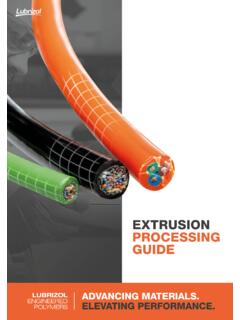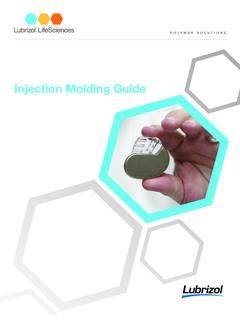Transcription of DISPERSANTS PRODUCT GUIDE - Lubrizol
1 PERFORMANCE COATINGSDISPERSION SOLUTIONS FOR PAINTS, COATINGS AND GRAPHIC ARTSDISPERSANTS PRODUCT GUIDES olsperse hyperdispersant technology is an essential ingredient for advanced performance in paint, coating and graphic art formulations. The technology enables the production of highly loaded, highly stable, broadly compatible dispersions in almost any combination of solid particles and continuous phases (liquid or solid). This dispersant technology combines polymeric stabilizing chains selected for solubility in a given solvent and/or resin combination, with anchor groups optimized for strong adsorption to the particle surface, where the dosage is determined by the particle s surface area.
2 This technology allows the production of sterically stabilized dispersions with higher solids content, lower viscosity, and improved viscosity and particle size stability compared to dispersions made using resins or lower molecular weight DISPERSANTS or surfactants. IMPROVED QUALITYS tronger, brightercolorsHighergloss Uniform flow and improved levelingBetter flocculation resistanceImproved stabilityMeet new environmental standards MORE EFFICIENT DISPERSIONCOST SAVINGSI ncreased productivityHigher pigment/filler loadingsIncreased color strengthLower energy usageUpgraded performance of lower cost systemsBENEFITS OF USING DISPERSANTSCONTENTSD ispersants for Graphic Arts and Digital InksProduct Selector GuideDispersants for Graphic Arts and Digital Inks ChartPage 10 Page 11 DISPERSANTS for Paints and CoatingsProduct Selector GUIDE DISPERSANTS for Paints and Coatings Chart Page 7 Page 8-9 Benefits
3 Of DispersantsFormulation Guidelines Method of Use and DosagePage 4 Page 4-523 SOLSPERSE HYPERDISPERSANT FORMULATION GUIDELINESMINIMAL RESINS olsperse hyperdispersants are widely used in applications where resins are a component of the millbase inks and paints. Anchoring of the Solsperse hyperdispersant to the pigment surface can be affected by competition between the resin and the hyperdispersant for the surface of the particle. Once the Solsperse hyperdispersant anchor group is attached to the pigment surface it will remain firmly attached. Molecules of resin, however, are transiently adsorbed on the surface of the pigment, and even though not firmly anchored, they can still hinder the Solsperse hyperdispersant anchoring process.
4 The competition for the pigment surface, resulting from using good wetting resins, is the most severe the presence of Solsperse hyperdispersants, good wetting or grinding resins need not necessarily be selected for use in the dispersion medium. Other resins, more suitable to end-film properties, can be used since Solsperse hyperdispersants will provide the essential pigment wetting function. We recommend that MINIMUM resin solids are used in the millbase, but present in sufficient quantities to produce the necessary let-down stability or to produce final coatings with the appropriate resin and solvent contents. If relatively good wetting resins are used, we recommend using approximately 10% resin-solids solution as the grinding medium, and for relatively poor wetting resins, the minimum amount up to the level conventionally FOR A HIGHER PIGMENT LOADINGS olsperse hyperdispersants typically will cause the millbase viscosity to be dramatically reduced.
5 Solsperse hyperdispersants will also reduce the viscosity of non-resin-containing dispersions plasticizer dispersions. This lowering of viscosity may occur to such an extent that there could METHOD OF USE AND DOSAGE1. Select the correct polymeric Solsperse hyperdispersant according to the solvent system in the millbase or tinter With certain organic pigments, it may be advantageous to include the use of a Solsperse synergist in combination with the hyperdispersant. The synergist helps to improve the polarity of the surface of various organic pigments ( phthalocyanine blue, green and certain carbon blacks) and increase the performance of the polymeric agent.
6 Solsperse 5000S (blue synergist for solvent based systems) Solsperse 12000S (blue synergist for water based and alcohol solvent systems) Solsperse 22000 (yellow synergist for solvent based systems)The recommended polymeric to synergist ratios are 9:1 (for high surface area carbon blacks), 4:1 (for medium surface area carbon blacks, blue, green), 9:1 (red, yellow).3. The quantity of Solsperse hyperdispersant to use is generally based on 2 mg/m2 of pigment surface area. The generic formula for the calculation of theoretical dosage is:be insufficient shear in the system to facilitate effective dispersion. It is therefore essential to increase the pigment content of a Solsperse hyperdispersant millbase to ensure adequate shear.
7 This is necessary for most effective pigment Active Solspersehyperdispersant on weight of pigmentpigment surface area (m2/g)5 However, for phthalocyanine blue, a Solsperse synergist ( Solsperse 5000S) is used in addition to the polymeric agent usually at a ratio of 4:1 polymeric agent to synergist. So the final millbase formulation would be:A ladder series of Solsperse hyperdispersant levels should be carried out around the 2 mg/m2 level. 4. Avoid other additives in the dispersion phase ( thixotropes) as they may interfere with the efficiency of the Solsperse hyperdispersant in its dispersion of the In general, use a low amount of resin in the dispersion (maximum of 10%) to try to minimize the competition between the resin and the Solsperse hyperdispersant for the wetting of the pigment surface.
8 % AOWP =10% polymeric agent on the weight of the , a typical dosage would be: Phthalocyanine blue pigmentPolymeric Phthalocyanine blue pigment Polymeric agentSynergist20% resin solids solution (equivalent to 4:1 ratio) example: typically the surface area of a phthalocyanine blue pigment is 50 m /g. (equivalent to 10% AOWP)6. The recommended order of addition is: a) Dissolve the Solsperse hyperdispersant into the millbase solvent(s) or in the solvent/resin mixture, ensuring that the PRODUCT is fully dissolved before proceeding further. b) If required, add the synergist and distribute evenly with stirring (note: the synergist is virtually insoluble).
9 C) Add the pigment(s) in stages and disperse in the normal As a result of the effect of the Solsperse hyperdispersant and the reduced resin solids, the dispersion viscosity is lower. To achieve an acceptable milling viscosity, gradually increase the pigment After milling, continue to process as normal, adding any other additives as needed, into the letdown For digital inks, the dosage will be considerably higher as levels of 6 mg/m2 to 10 mg/m2 are For viscous inks, such as offset lithographic heatset or sheetfed inks, the resin solids in the dispersion will be higher to accommodate the final printing viscosity and also to facilitate the transfer of the millbase over the three roll mill.
10 A solids of 40% (40/60, solid varnish/solvent) is a polymeric dispersant to be effective, it must be soluble in the solvent into which the pigment or filler is being dispersed. The solvent medium used during dispersion is therefore the main criteria used in dispersant selection. Solsperse hyperdispersants available for use in paints and coatings applications are highlighted in the following PRODUCT selection chart for a range of solvents:With certain organic pigments, it may be advantageous to include the use of a Solsperse synergist in combination with the polymeric Solsperse DISPERSANTS . The synergists help to improve the interaction between the polymeric agent and the surface of certain organic pigments ( phthalocyanine blues, greens) and carbon black pigments.




